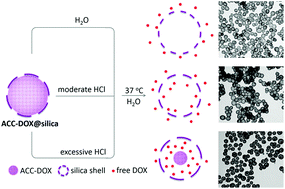Engineered doxorubicin-calcium@silica nanospheres with tunable degradability for controlled drug delivery†
Abstract
Although silica materials have been widely used as drug delivery carriers, the intrinsic stability of inorganic –Si–O–Si– frameworks largely limits their applications. Herein, we develop a simple “one-step acid treatment” method to fabricate a series of inorganic nanomedicines, which are denoted as doxorubicin-calcium@silica (DOX-Ca@silica), with tunable degradability for controlling drug release on the basis of a degradable pure silica framework in a physiological environment. After the acid treatment, the interactions between calcium and the silica shell have been tuned according to the concentration of acid. Then in the following physiological environment, due to the calcium salt-assisted silica decomposition, the silica shells exhibit various degrees of degradability, which control the drug release behaviors for efficient cell-killing both in HeLa cells and in drug-resistant MCF-7 tumor cells. As an alternative to organic or organic–inorganic hybrid materials for precisely controlled drug release, these DOX-Ca@silica nanospheres demonstrate a novel design and application in the development of multifunctional materials for drug delivery.

- This article is part of the themed collection: Inorganic Chemistry Frontiers HOT articles for 2017


 Please wait while we load your content...
Please wait while we load your content...